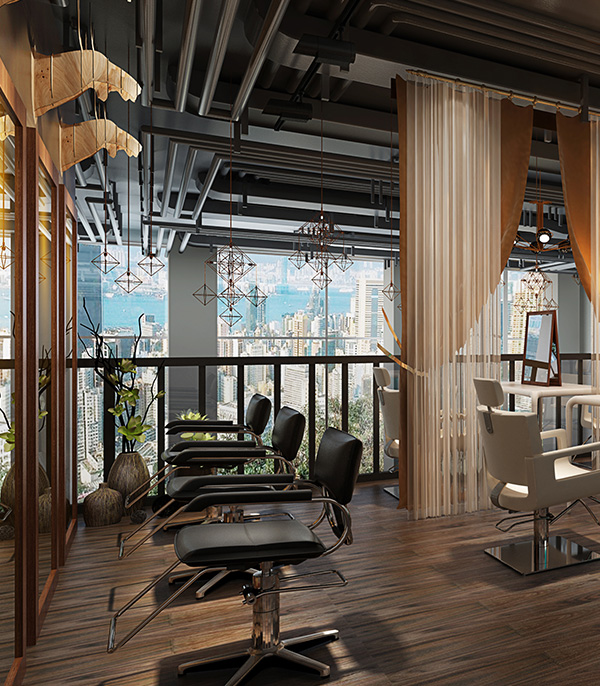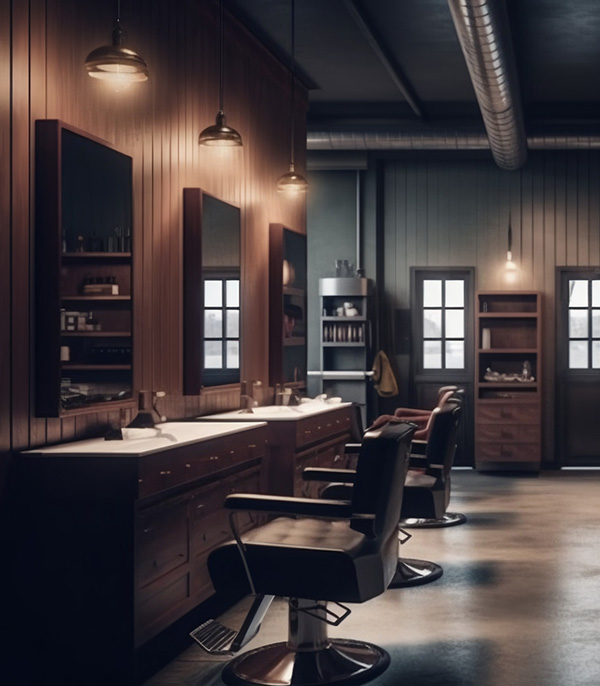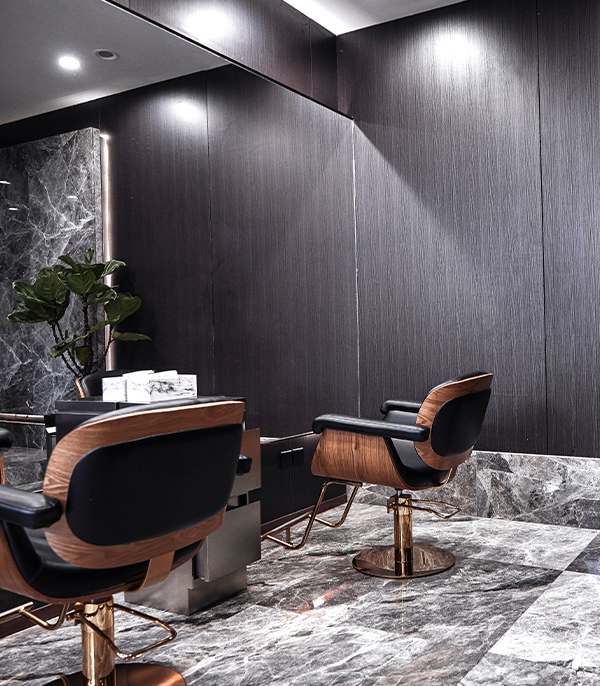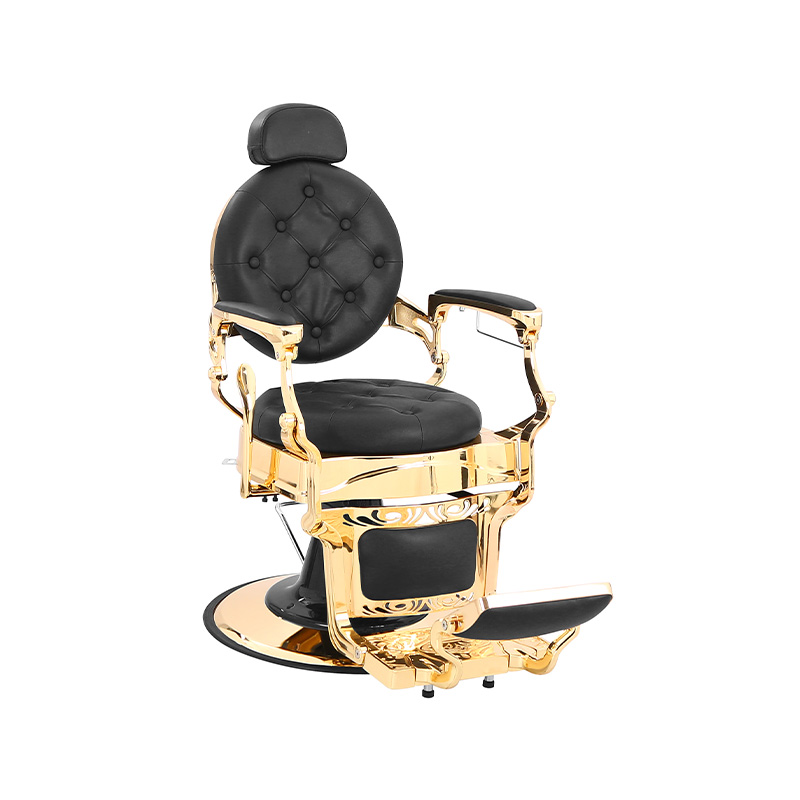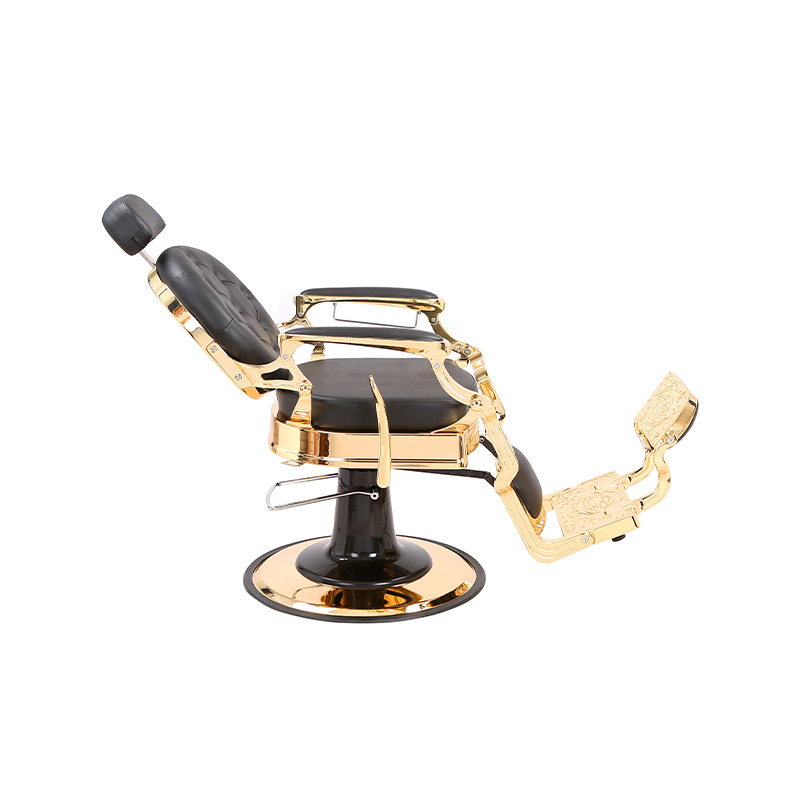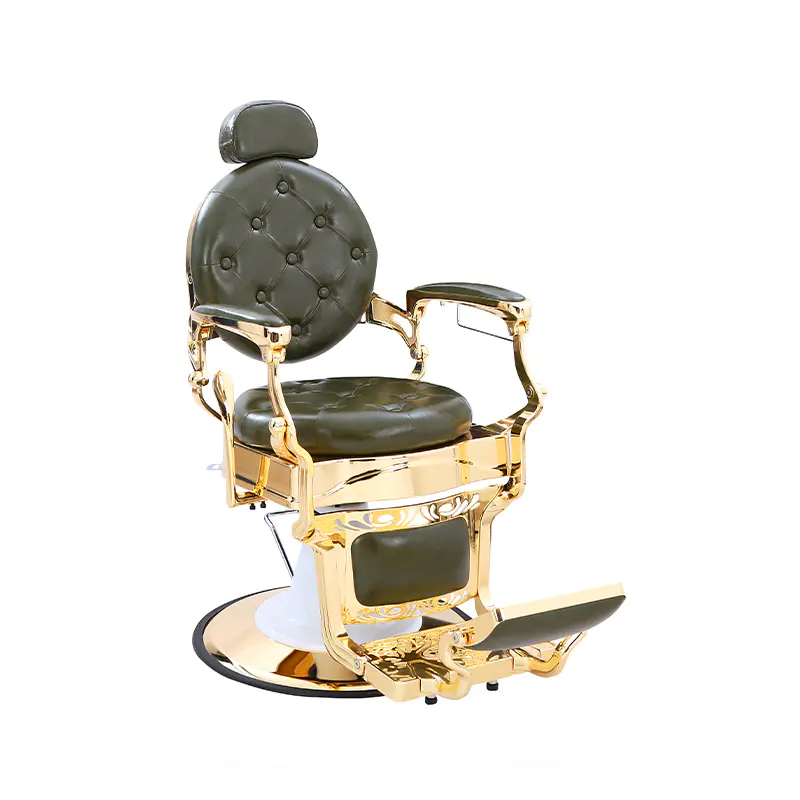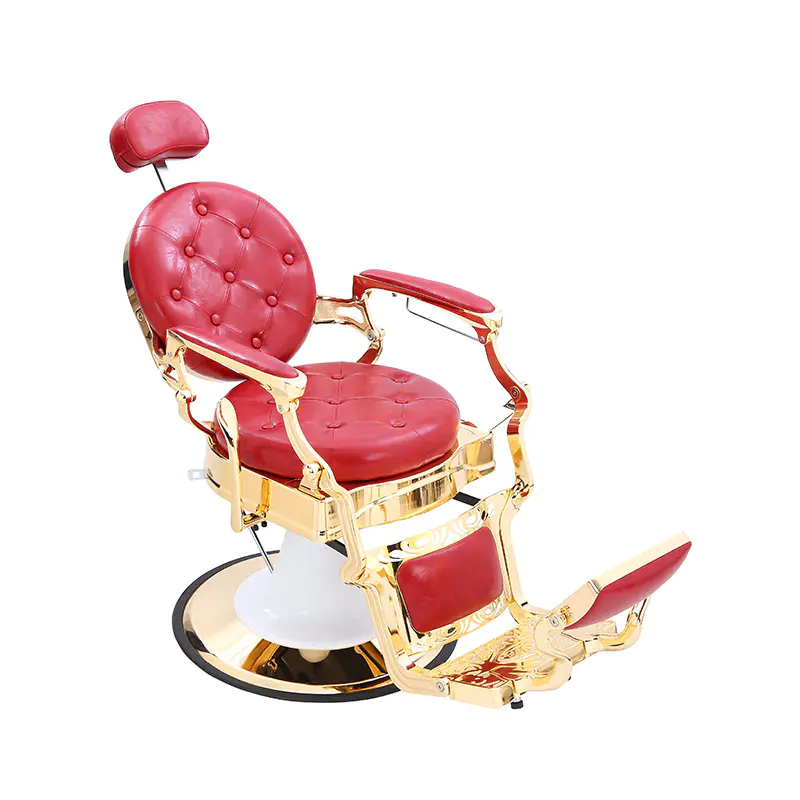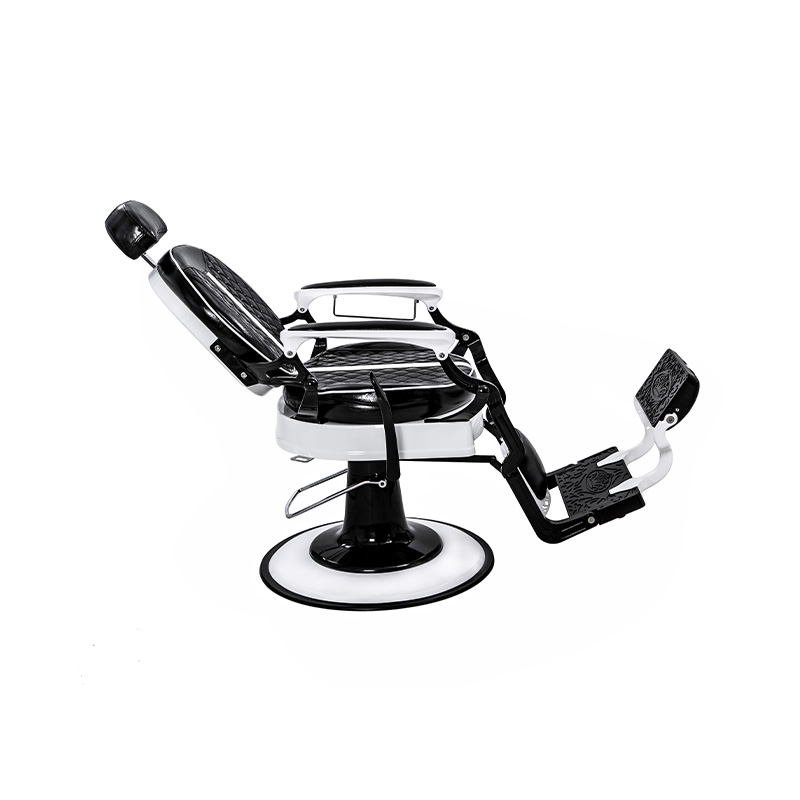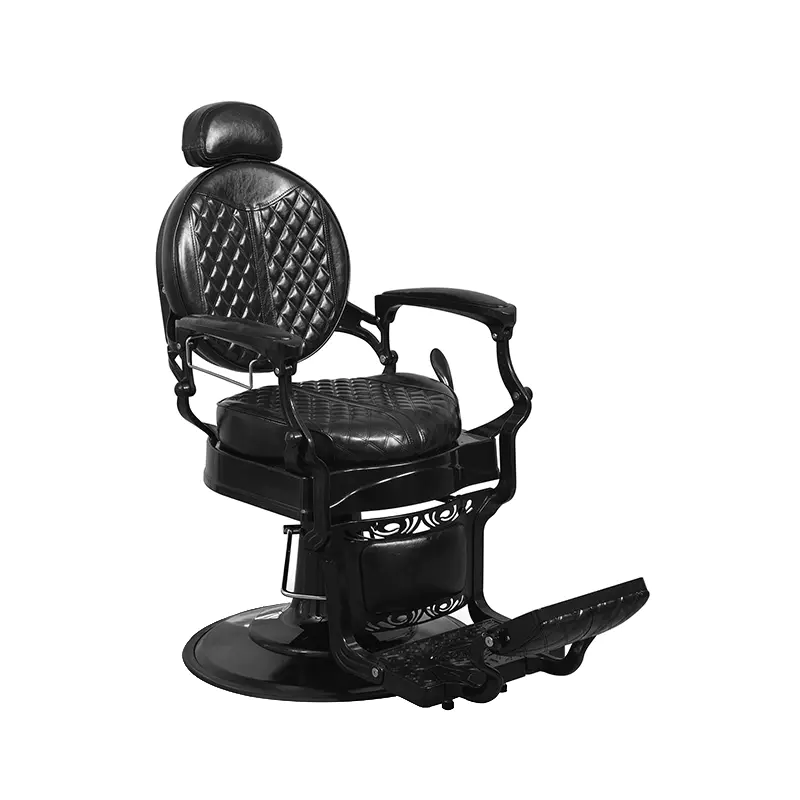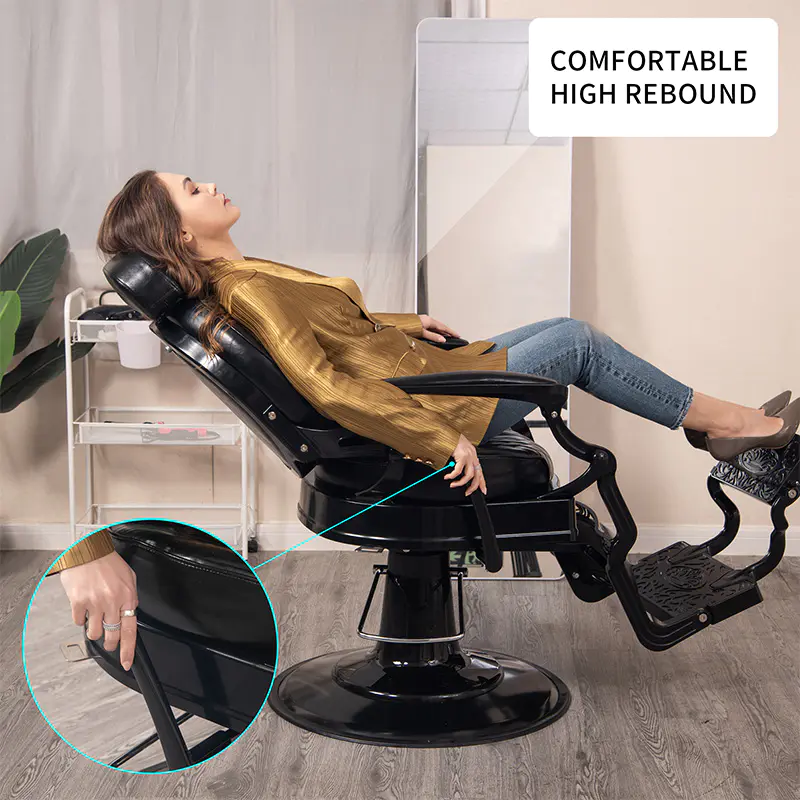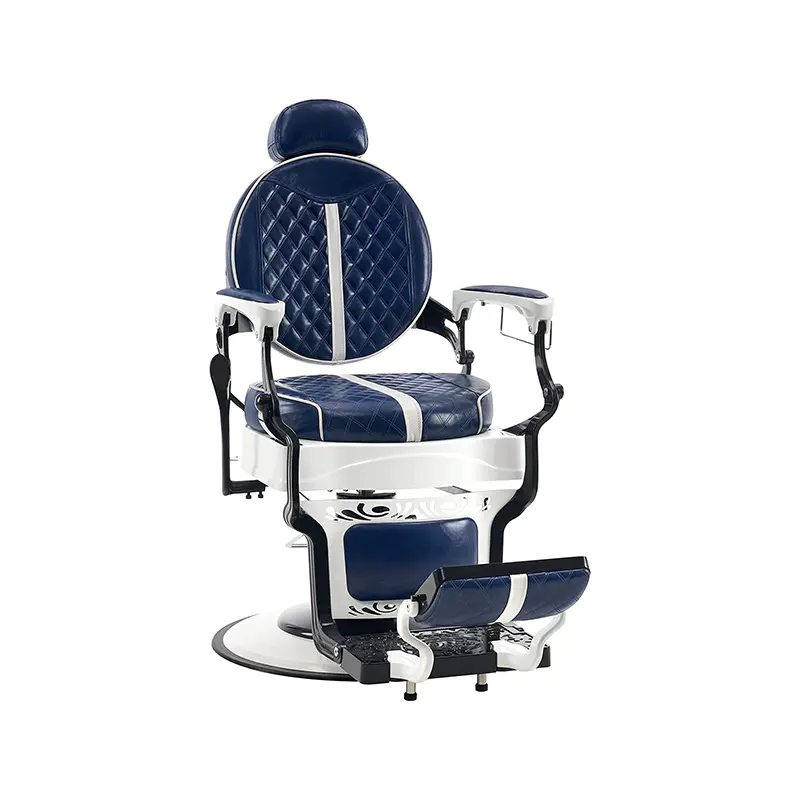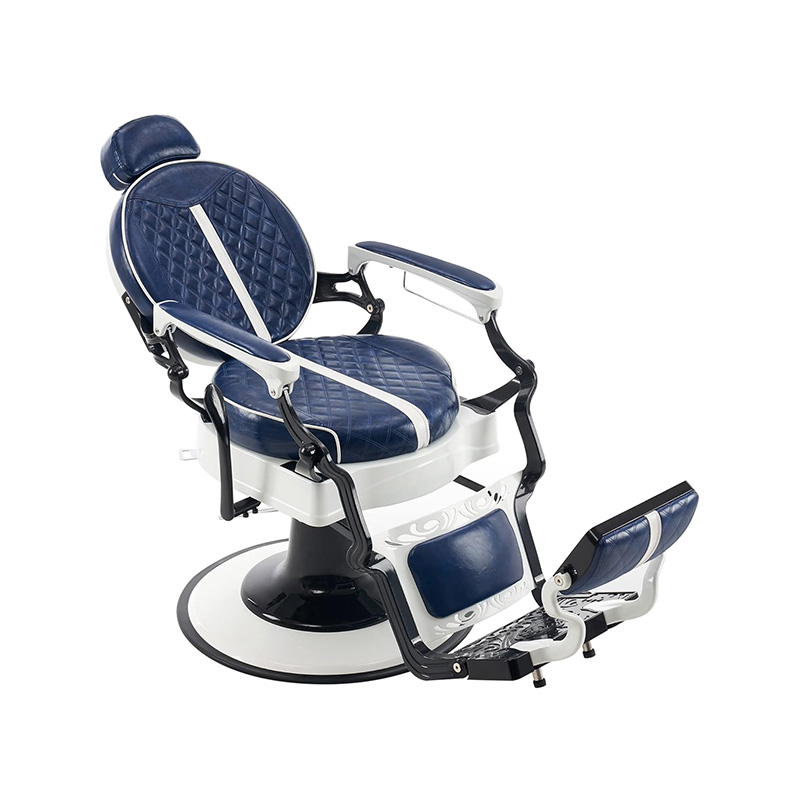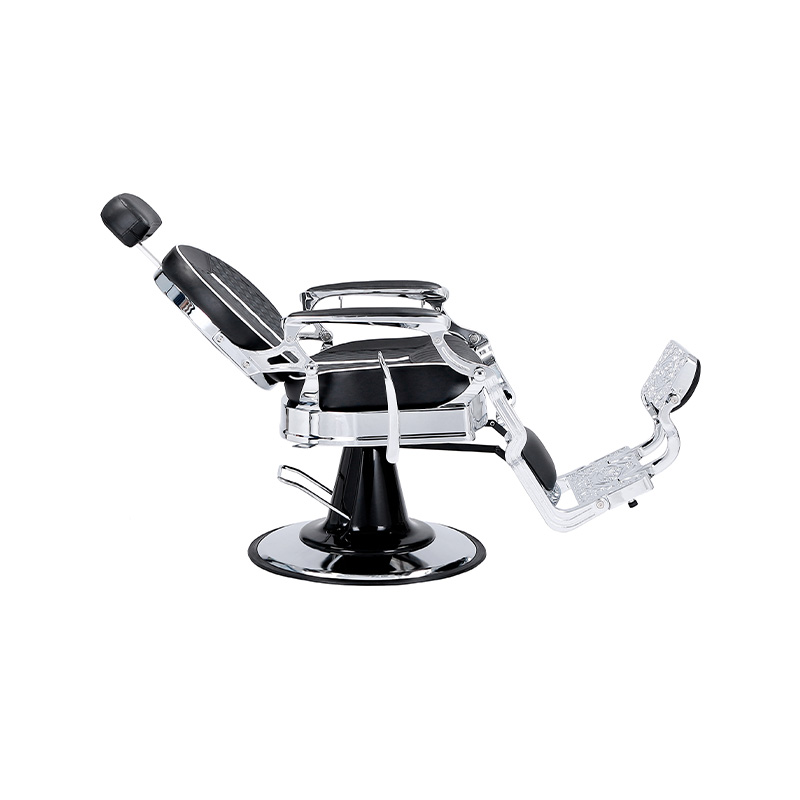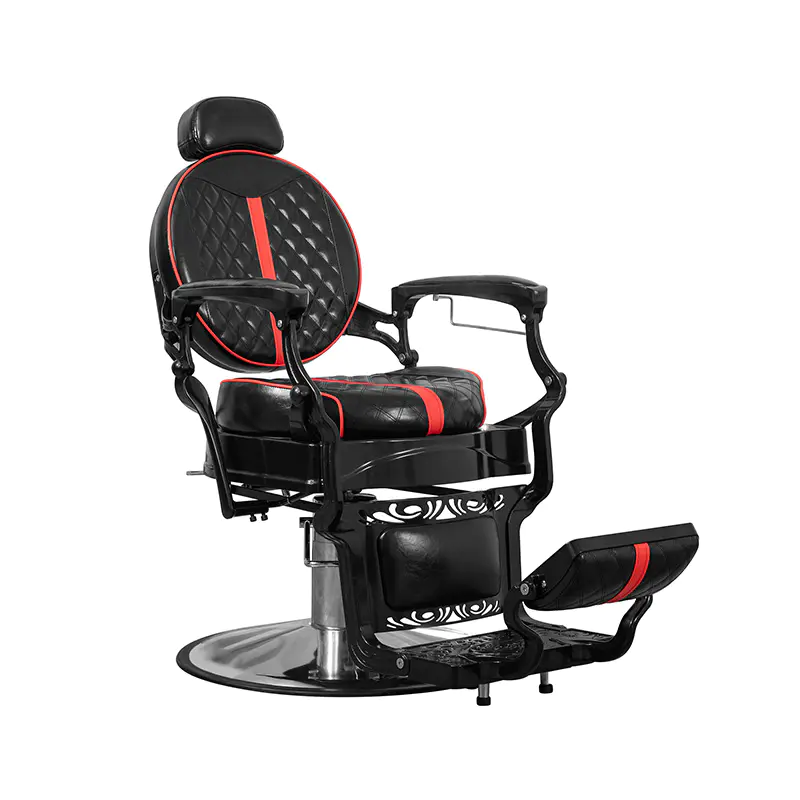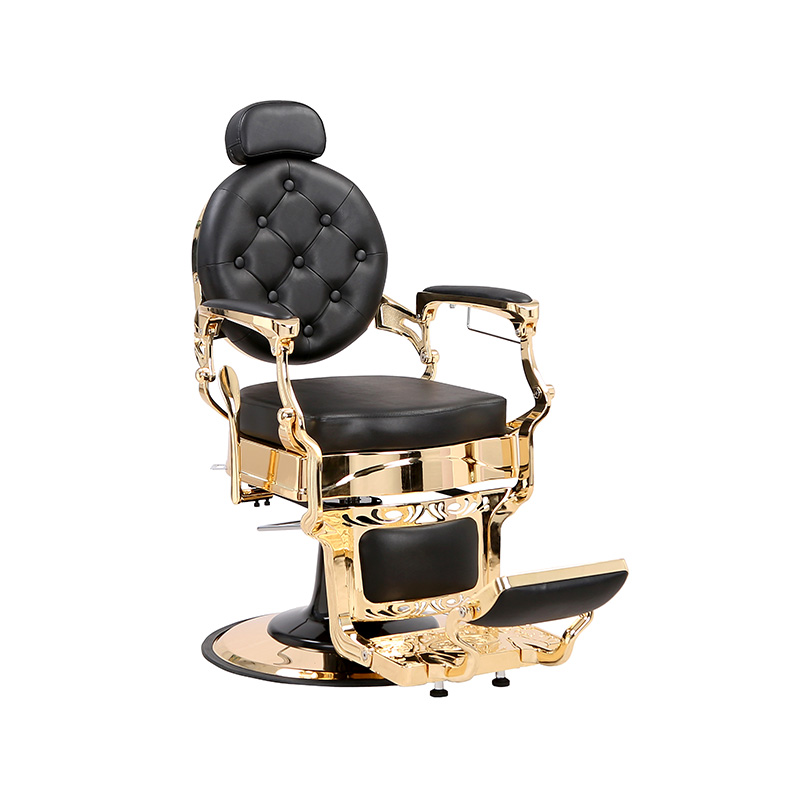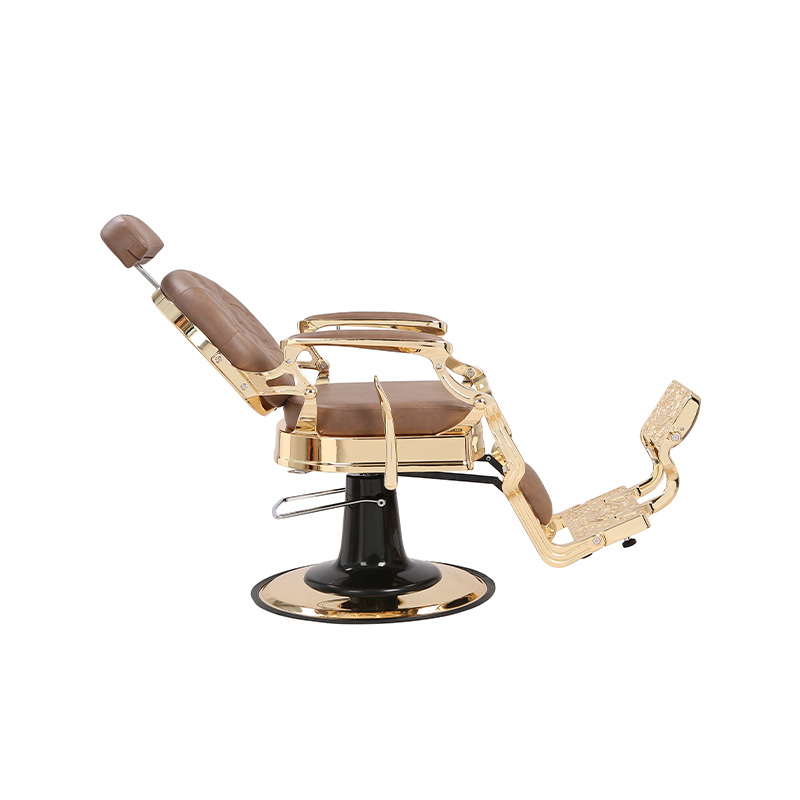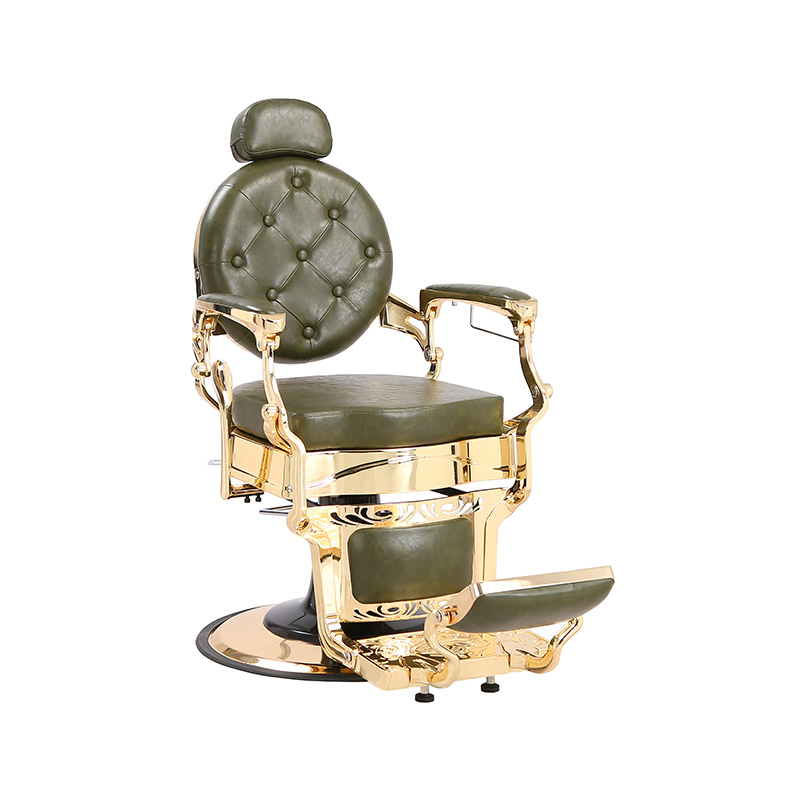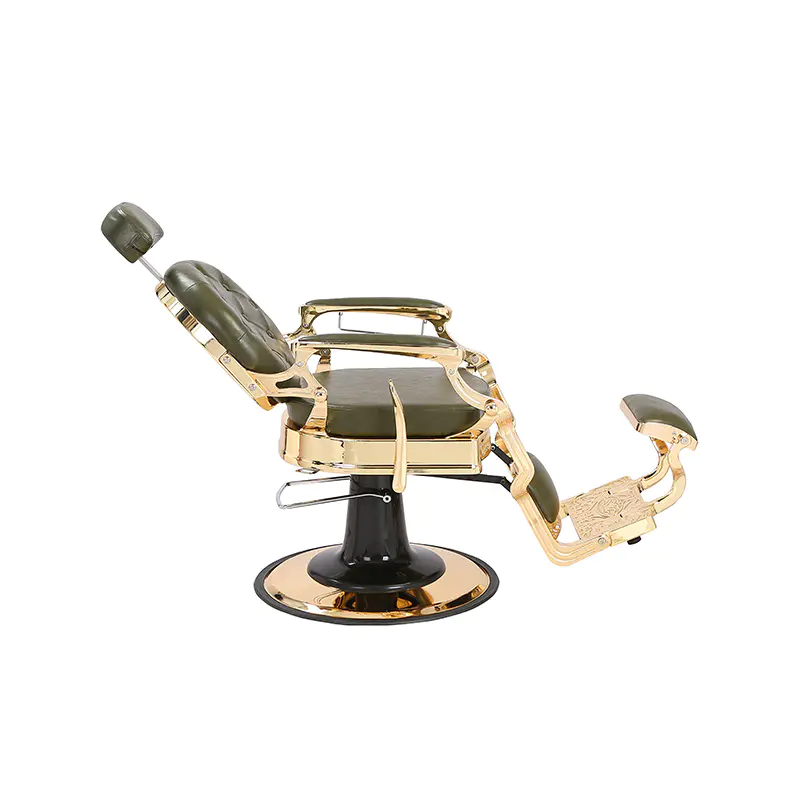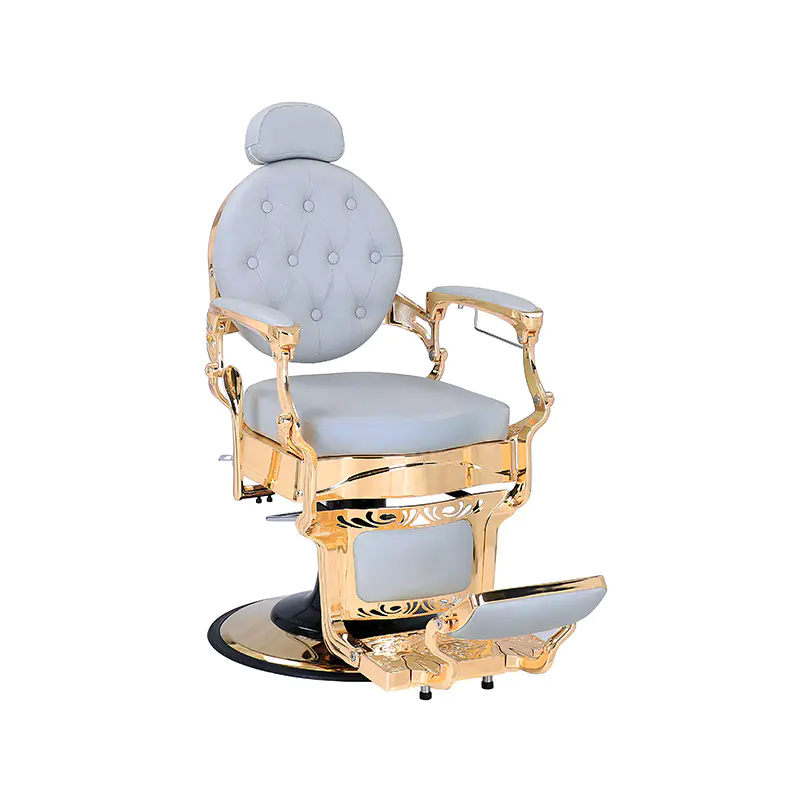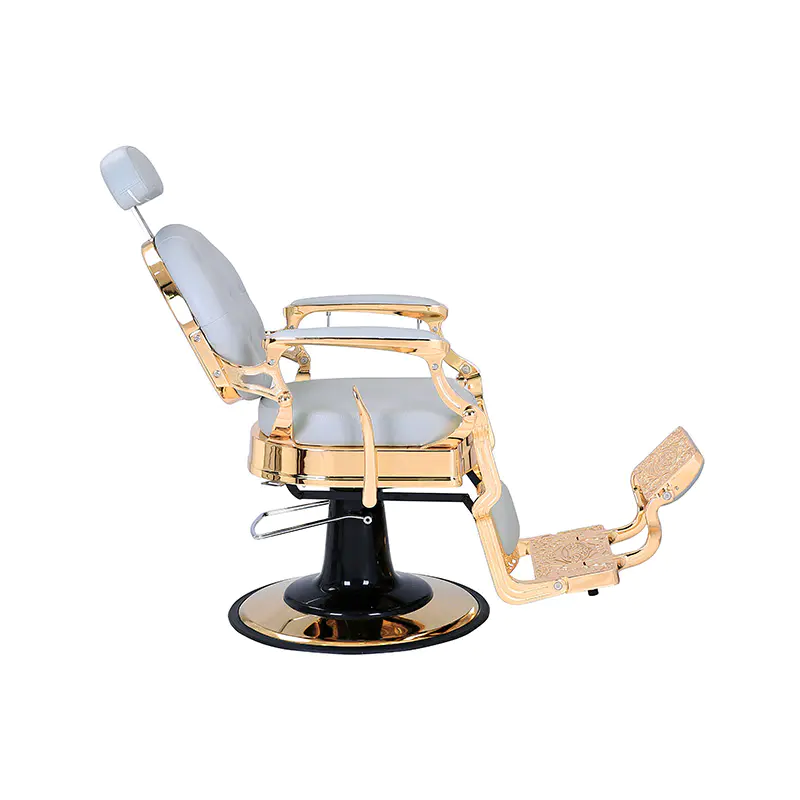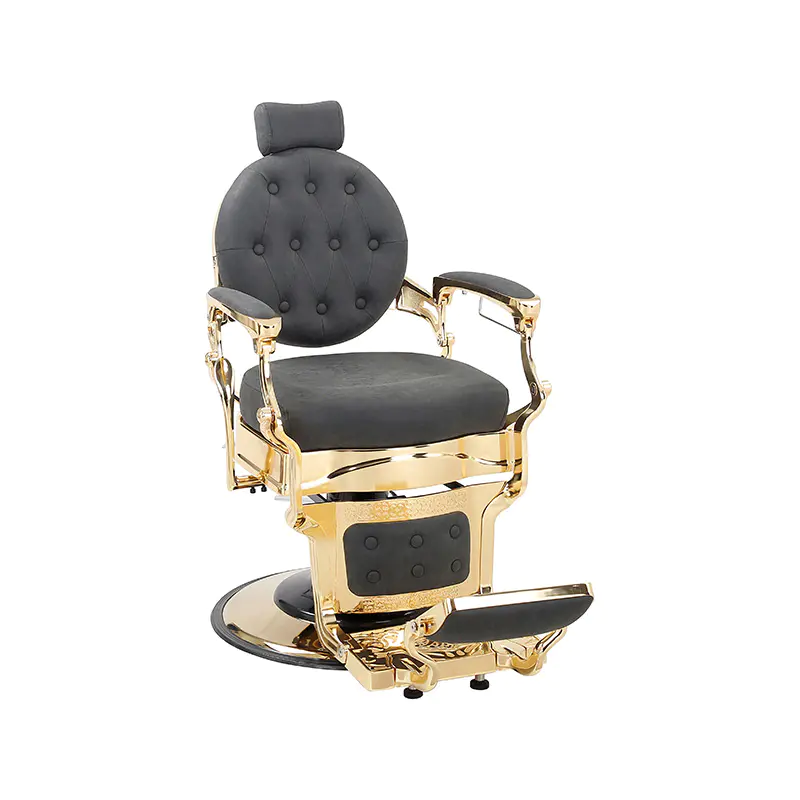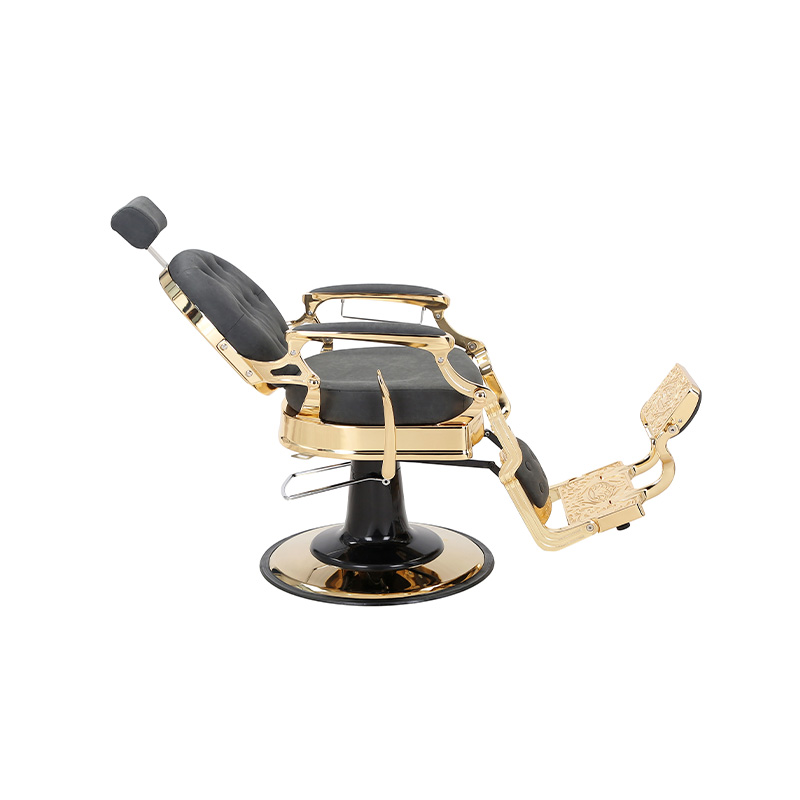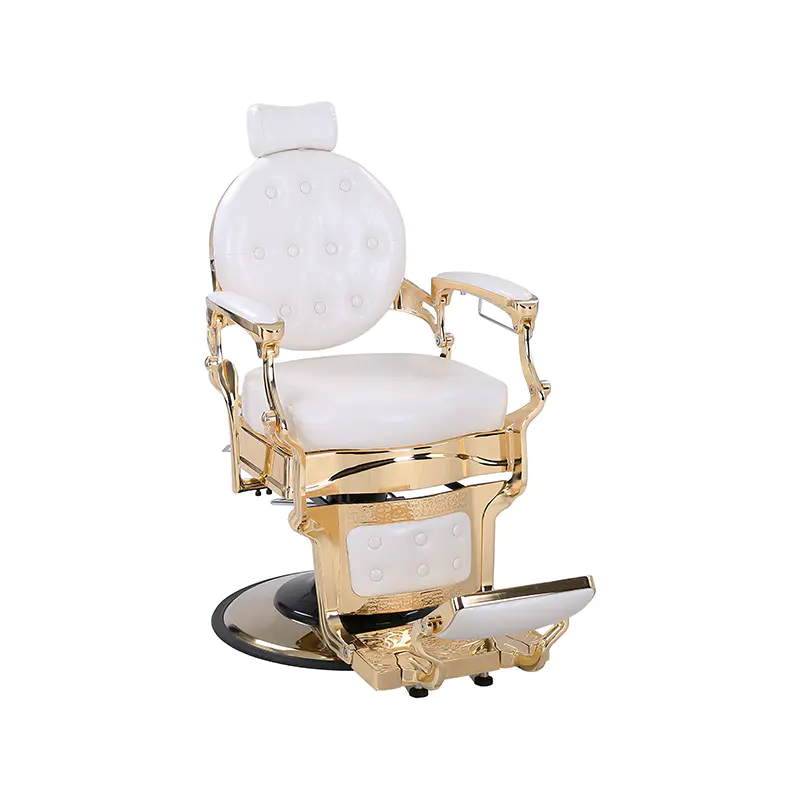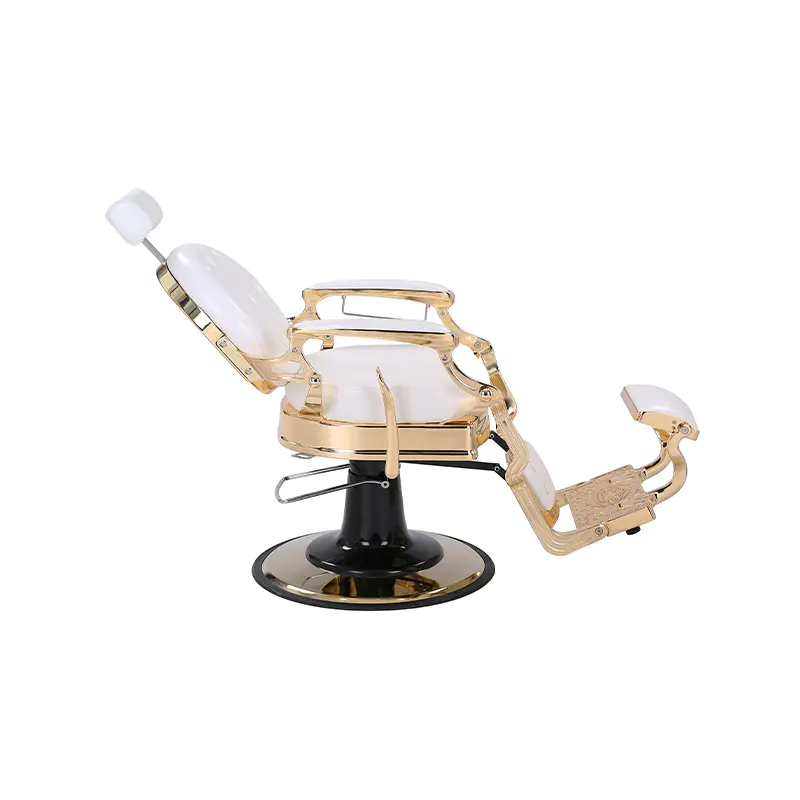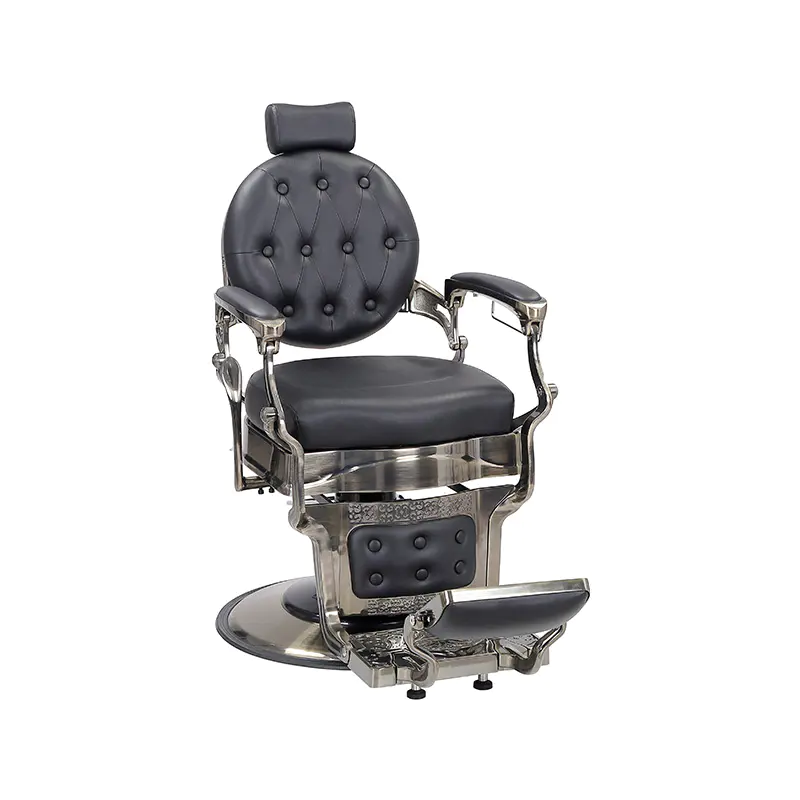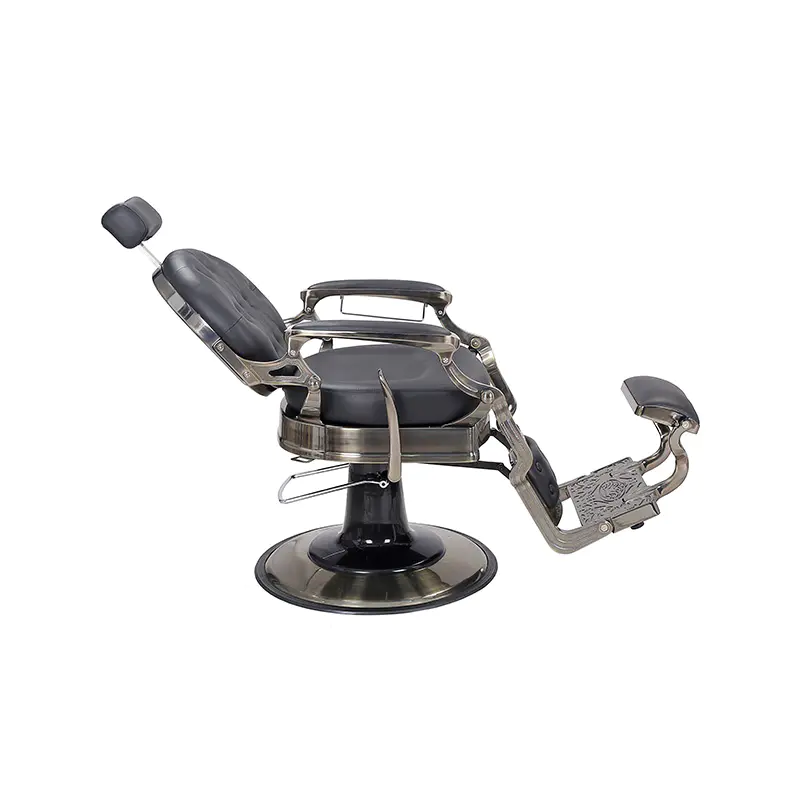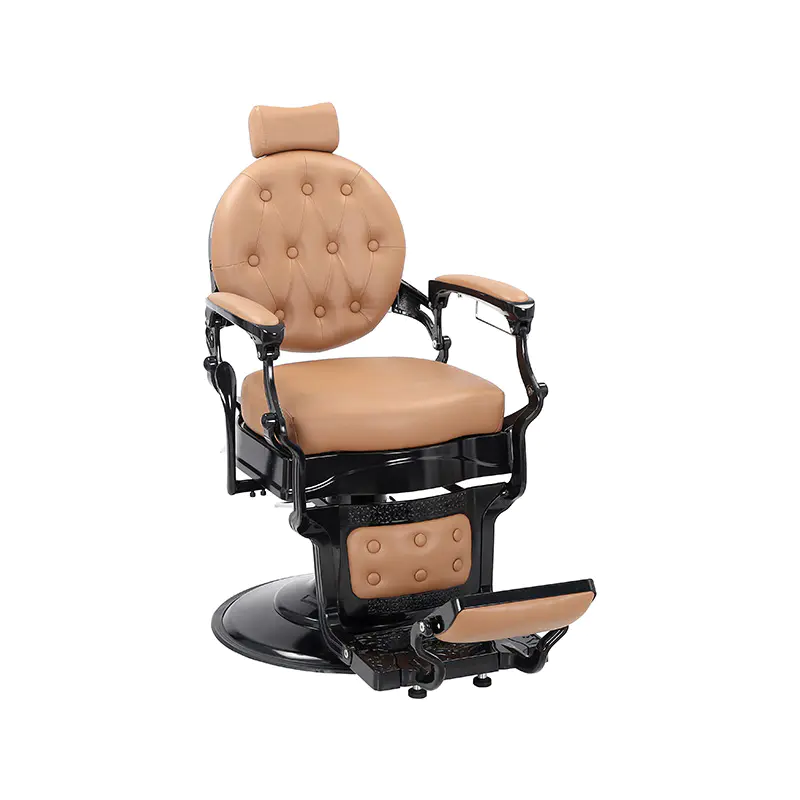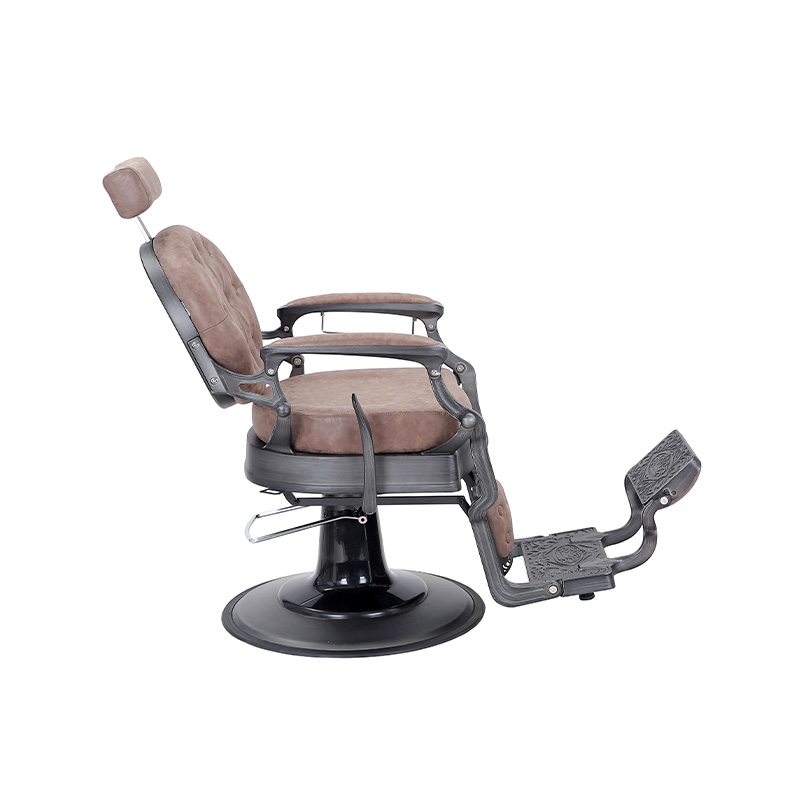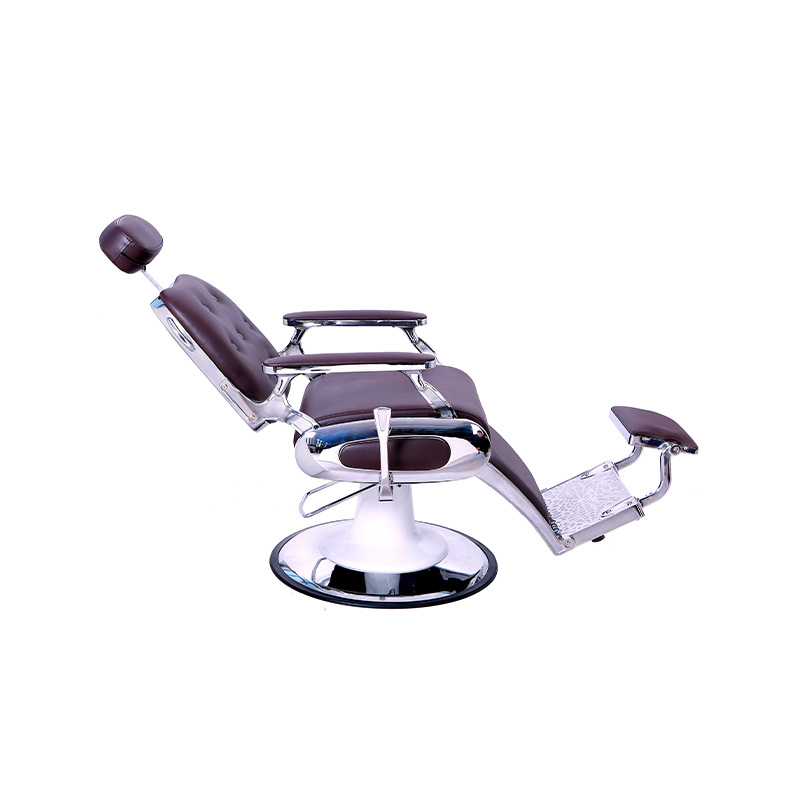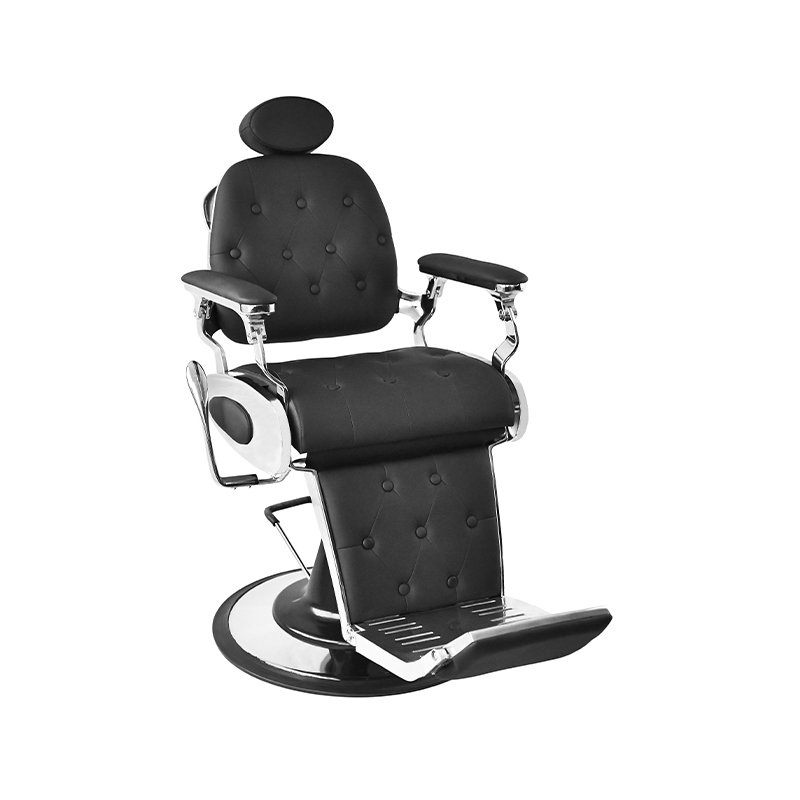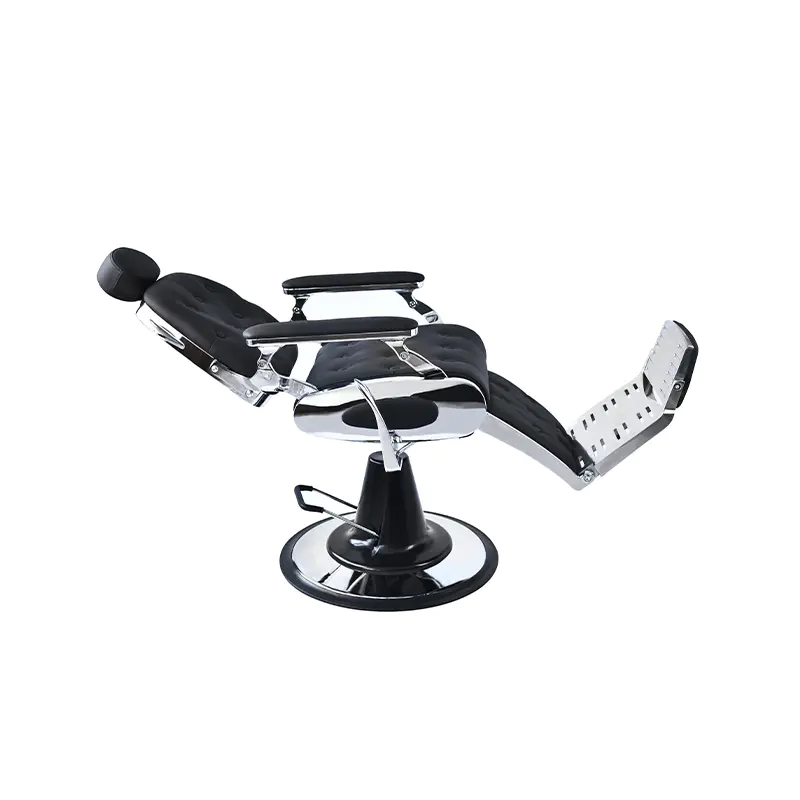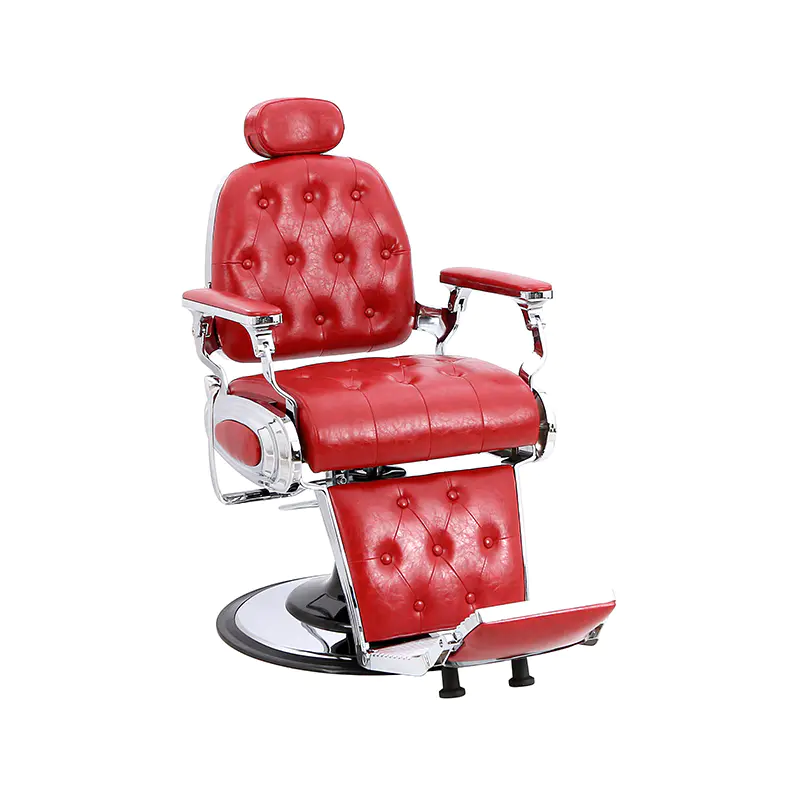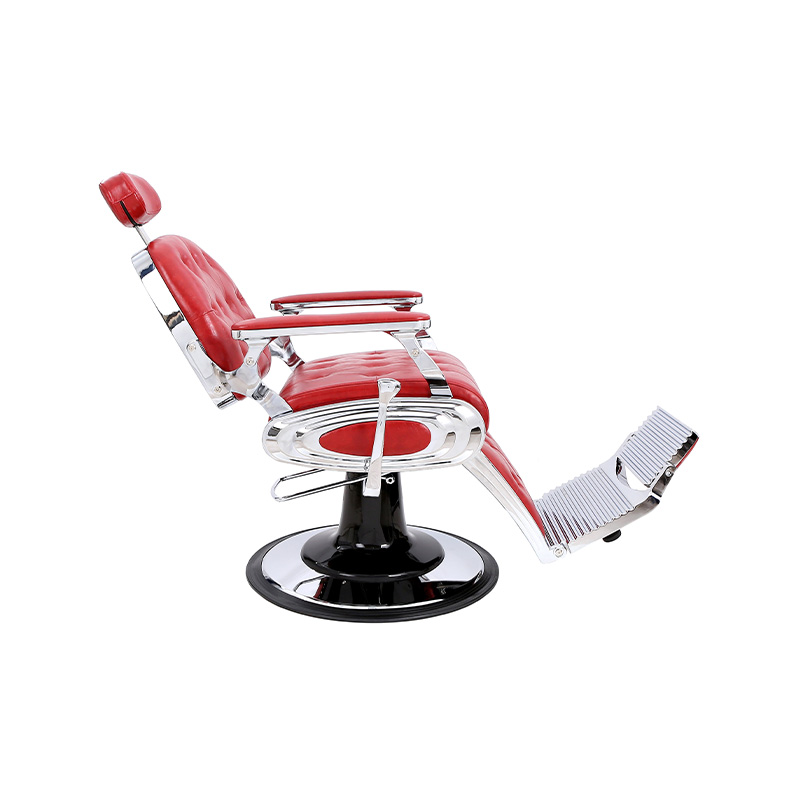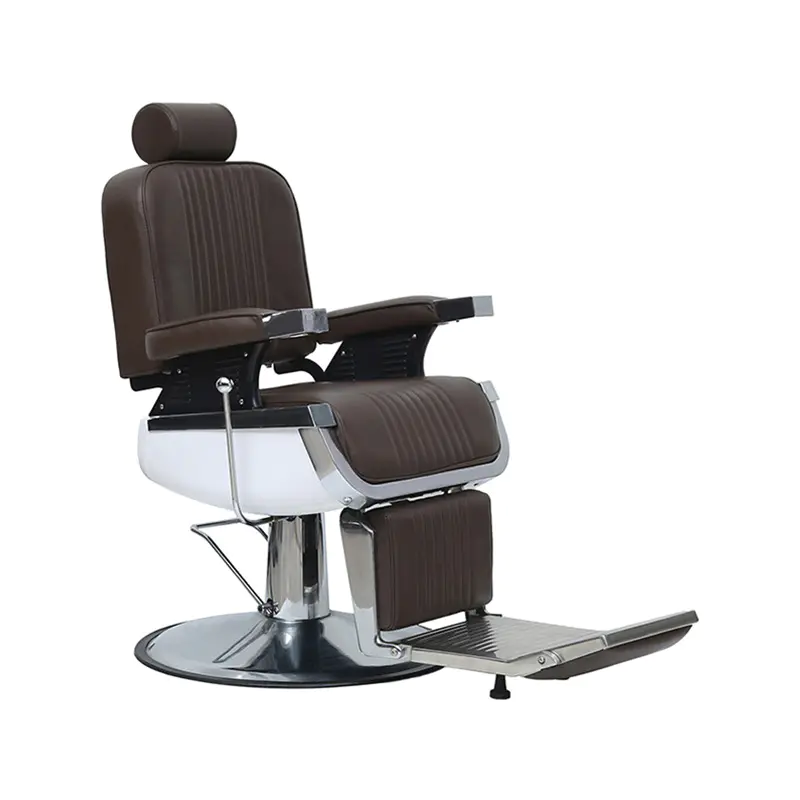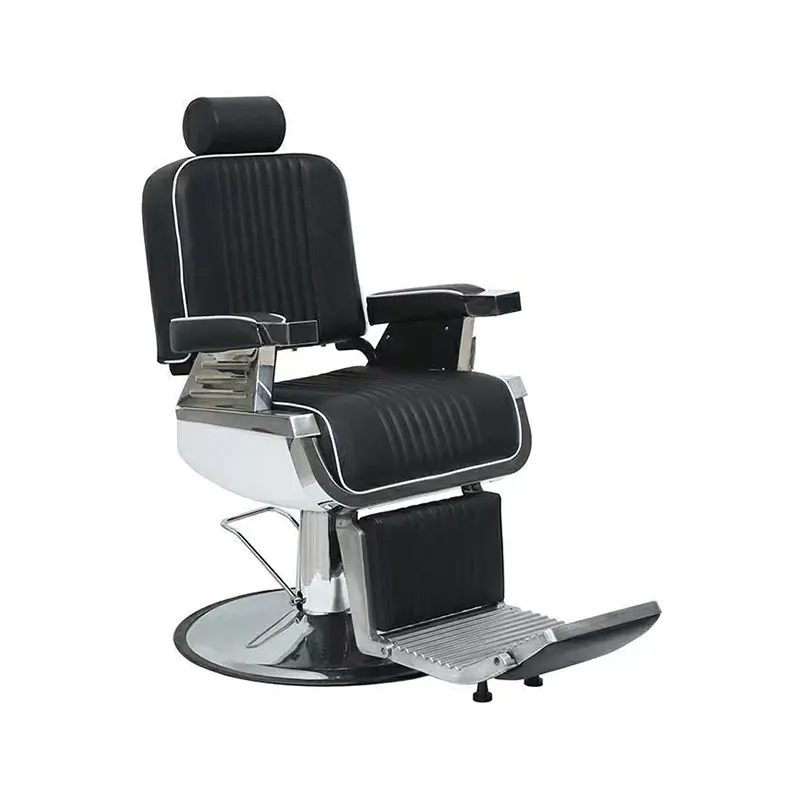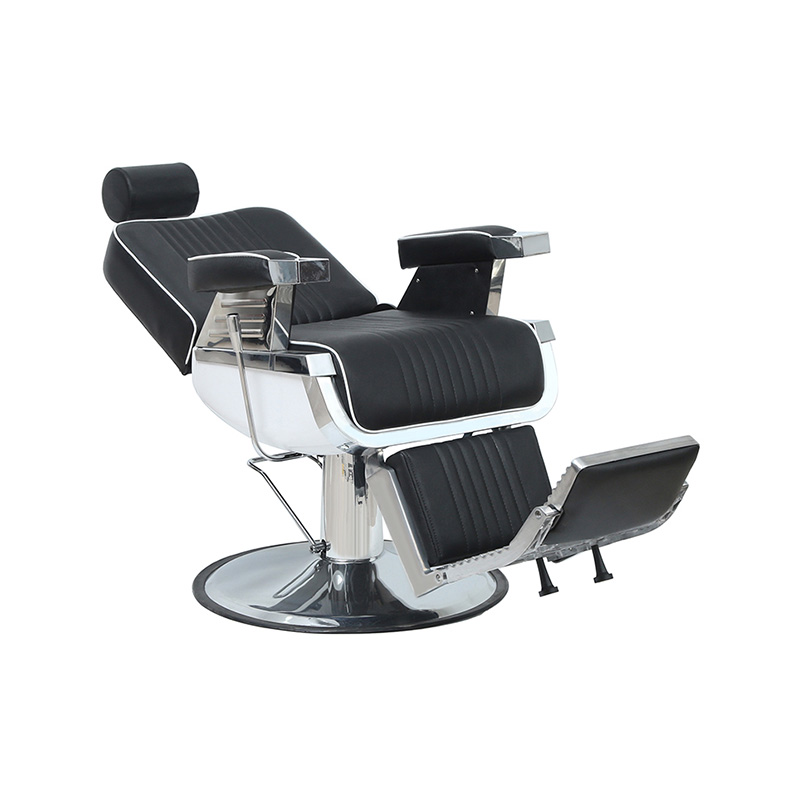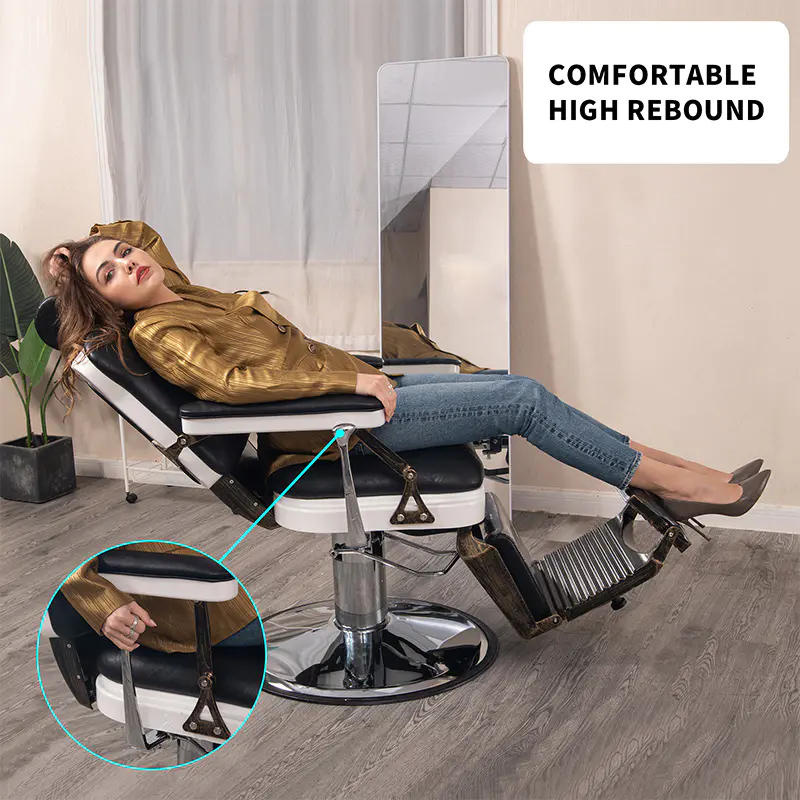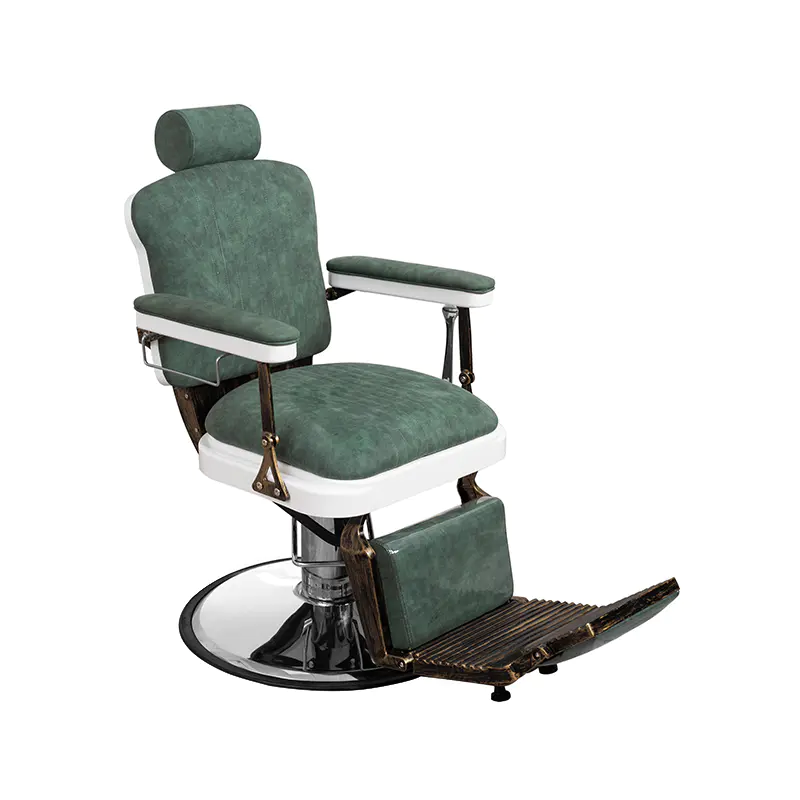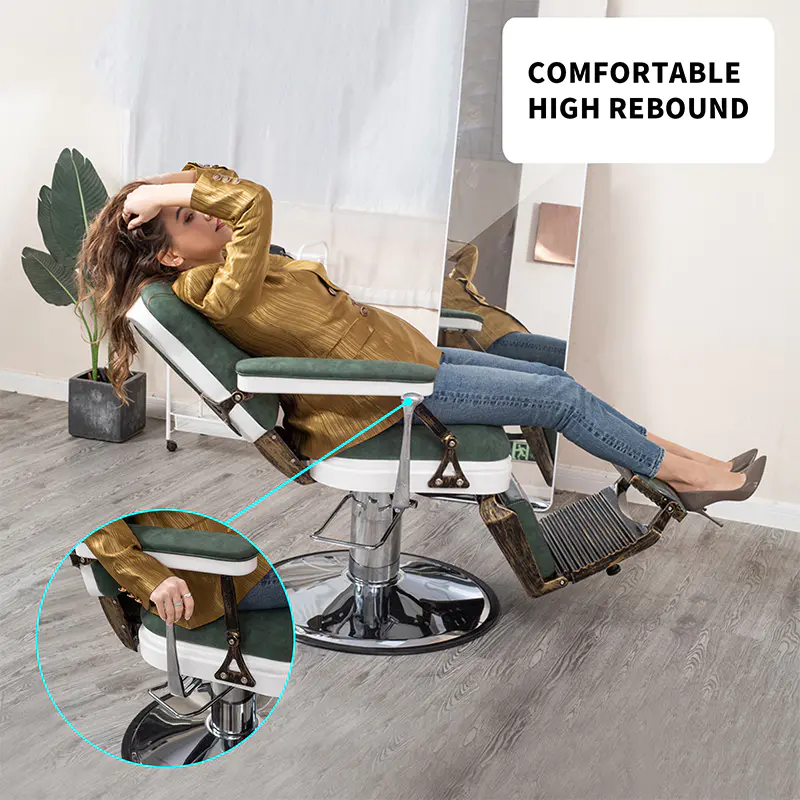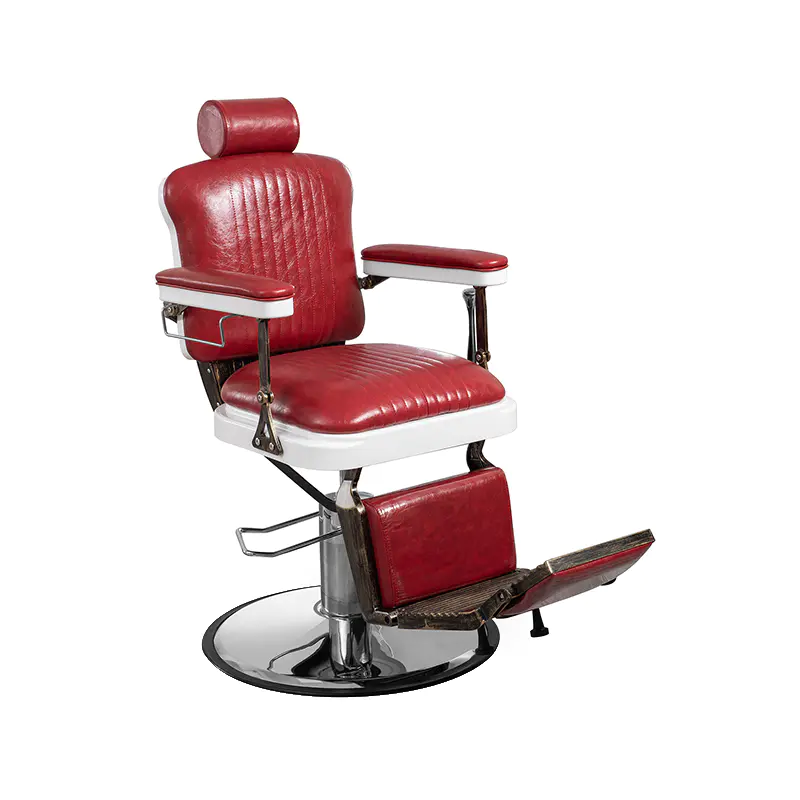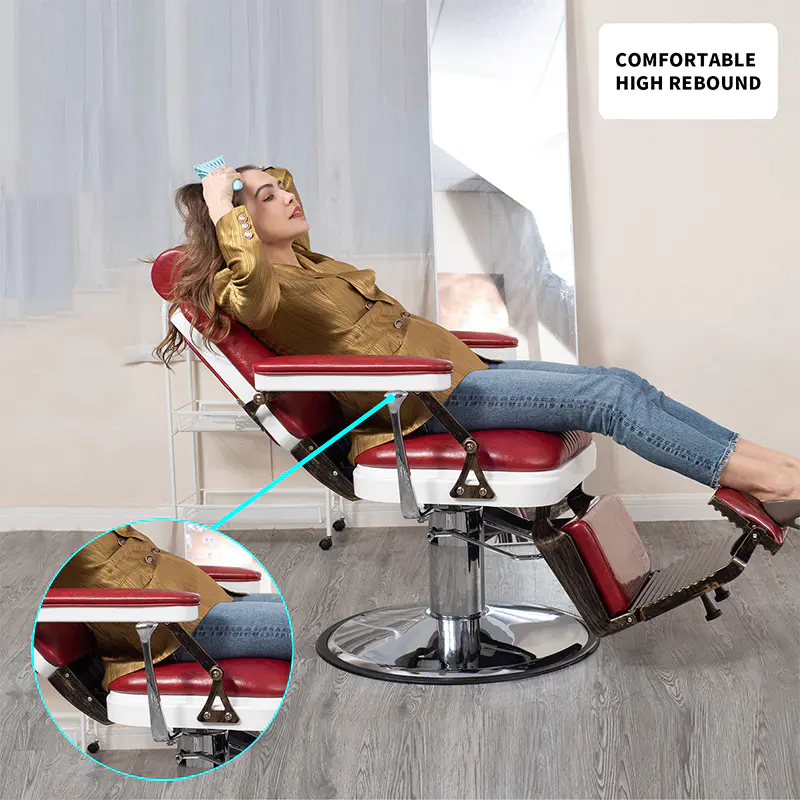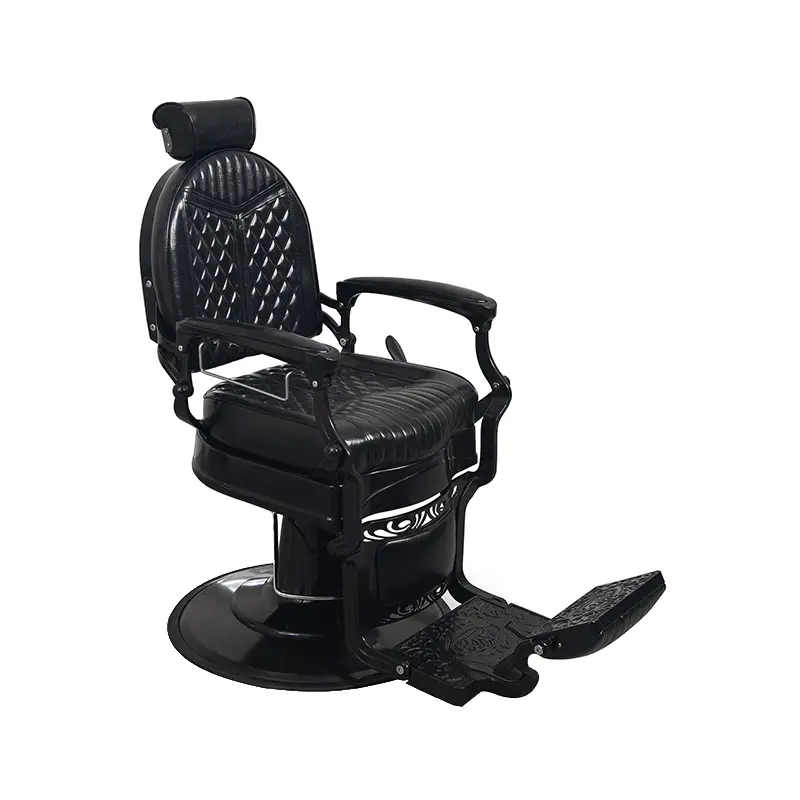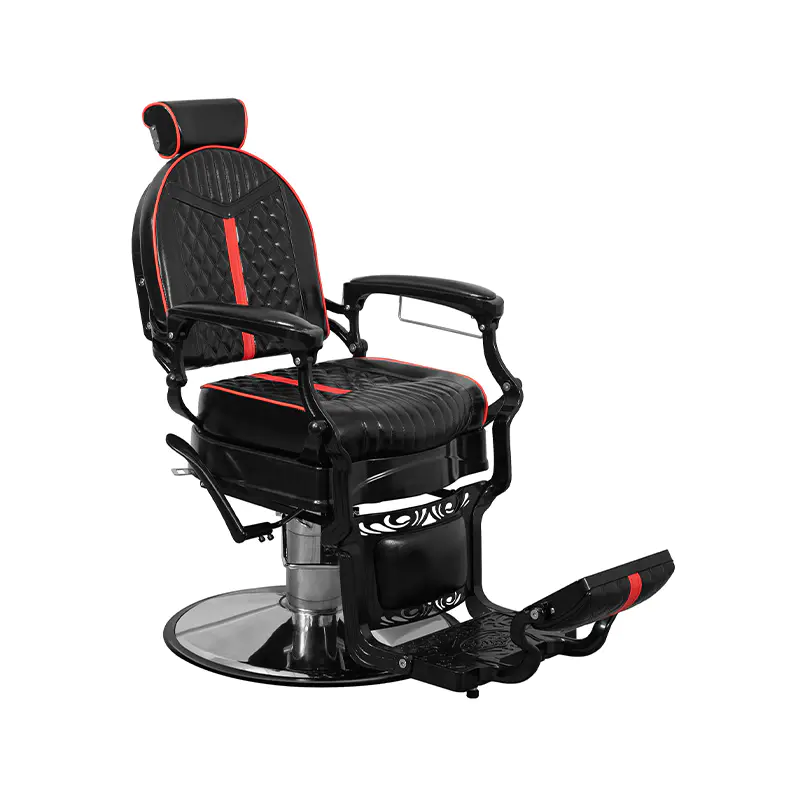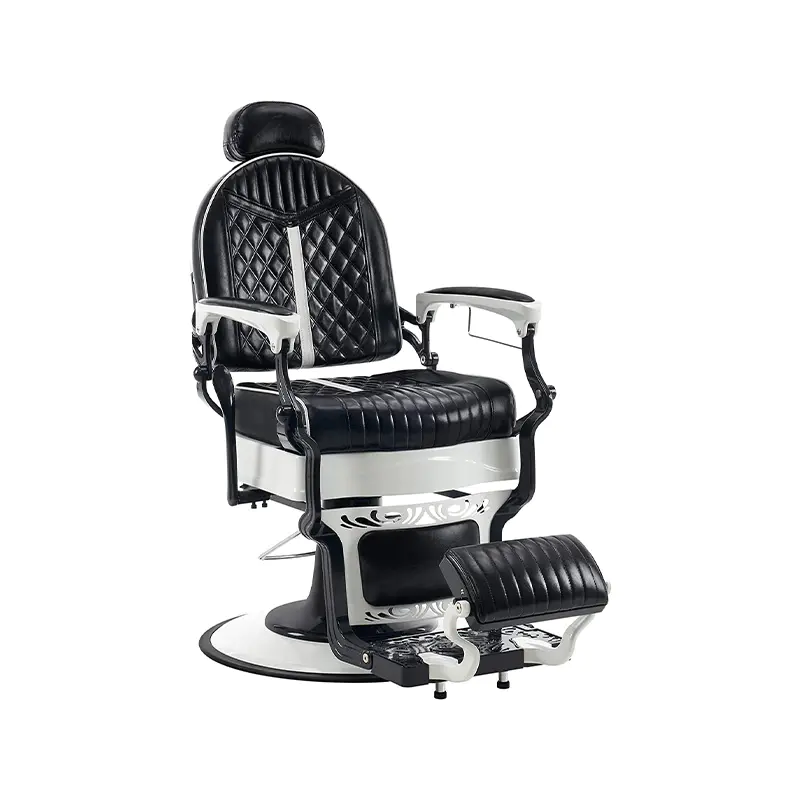1. What is a Barber Chair?
A barber chair is a chair used in barbershops, hair salons, or hair parlors. It is the core equipment used by hairdressers to provide services such as haircuts, styling, shampooing, perming, and
dyeing.
It is not just an ordinary chair, but a specially designed tool that integrates functionality, comfort, and professionalism.
The following are some key features and components of a barber chair:
(1) Main Features and Functions
Liftable Backrest
This is the most basic and important function of a barber chair. There is a foot pedal hydraulic pump (or electric button) under the chair, which hairdressers can use to adjust the height of the
chair by stepping on or pressing it, so that they can work in the most comfortable posture and avoid fatigue caused by prolonged bending.
Reclining Backrest
The backrest of the barber chair can recline. This function is mainly used for washing customers' hair in the shampooing area. Customers can comfortably recline, with their heads resting in the
recessed area of the shampoo basin, making it convenient for hairdressers to rinse and massage.
360-Degree Rotation
The chair can easily rotate in any direction. This allows hairdressers to trim different sections of hair without having to walk around the customer; they can simply rotate the chair, greatly
improving work efficiency.
Headrest: An adjustable or detachable U-shaped headrest keeps the customer's head stable and comfortable during a haircut. It is usually removed or flipped up during a shampoo.
Armrests: Fixed or foldable armrests provide support for the customer's arms, increasing comfort.
(2) Materials and Design of the Barber Chair
Base: Usually very heavy and sturdy, made of metal to ensure the chair does not tip over during lifting and rotating.
Chair Body: Traditional barber chairs are often covered in leather or synthetic leather because they are aesthetically pleasing, durable, and easy to clean. Modern barber chairs also use various
fabrics, plastics, or composite materials.
Design Styles: From classic retro styles (such as the red, white, and blue rotating lamppost, a hallmark of classic barbershops, often paired with chairs of this style) to minimalist modern
styles, there is a wide range available to match the overall décor of the salon.
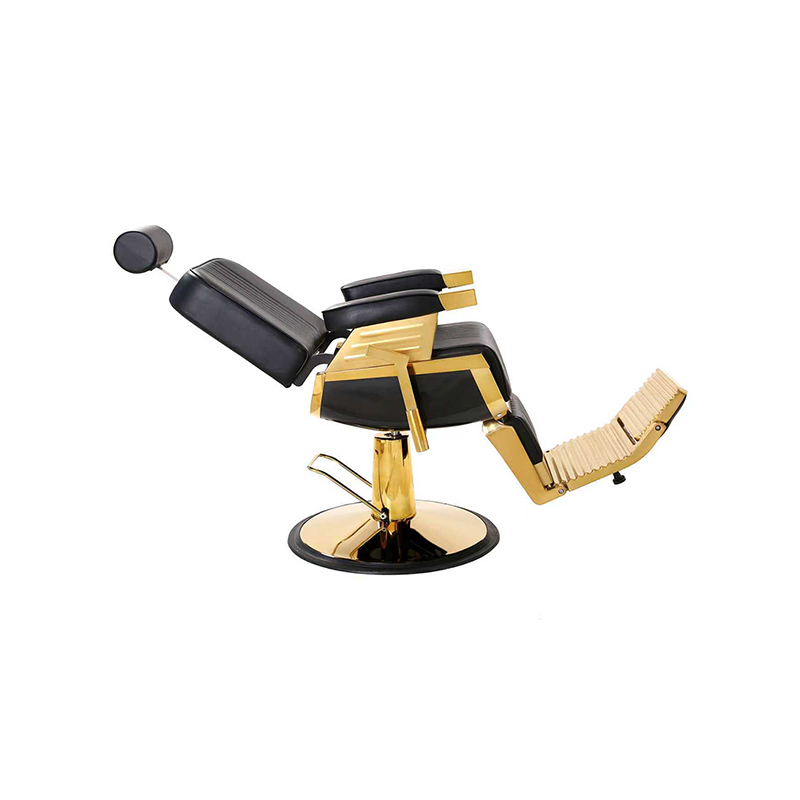
2. What are the functions of a barber chair?
The barber chair serves far more than simply "allowing people to sit while getting a haircut." It is a meticulously designed professional system aimed
at simultaneously improving the efficiency of hairdressers and the comfort of customers.
The following is a detailed breakdown of the core functions of a barber chair:
(1) For hairdressers: A professional tool for improving efficiency and comfort
Adjustable height (core function)
Hairdressers can easily adjust the chair height using a foot-operated hydraulic pump or electric button.
Function: Allows hairdressers to work in the most comfortable and natural posture, without the need for prolonged bending or raising of the arms, effectively preventing occupational injuries
(such as lower back pain), and ensuring hand stability and precision during haircuts.
360-degree rotation
The chair can easily rotate in any direction.
Function: When trimming different areas of hair (such as the left side, right side, and back of the head), hairdressers do not need to walk around the customer; they can simply rotate the chair.
This greatly optimizes the workflow and improves efficiency.
Reclining backrest
The backrest can recline, allowing the customer to be in a semi-reclining position. Function: This is crucial in connecting the "haircut" and "shampoo" processes. When the chair back is reclined,
the customer's head can comfortably rest in the recessed area of the shampoo basin, facilitating the hairdresser's rinsing, massage, and other procedures.
(2) For the customer: Ensuring a safe and comfortable experience
Providing stable and secure support.
The sturdy and heavy base ensures the chair will never tip over during lifting, lowering, and rotating, giving the customer a strong sense of security.
The armrests and ergonomically designed backrest allow customers to maintain a relatively comfortable posture during services lasting half an hour or even several hours.
Thoughtful headrest design.
The detachable or adjustable U-shaped headrest has two important functions:
During a haircut: It provides stable support for the head, preventing head movement from affecting the haircut's effect, and also allows the customer's neck to relax.
During a shampoo: It can usually be removed or flipped up, leaving space for the back of the neck, making the lying-down shampooing posture more comfortable.
Creating a relaxing psychological environment.
Sitting in a professionally designed, comfortable, and stable chair can help customers relax. This feeling of being "treated professionally" is the beginning of a good service experience.
(3) For the entire hair salon: The combination of function and aesthetics
Space setting and brand image
The style of the barber chair (such as retro leather, modern minimalism, futuristic technology) directly defines the overall decoration style and brand image of the salon, and is an important
visual element to attract target customers.
Hygiene and ease of cleaning
The surface of the barber chair is usually made of leather or high-quality artificial leather because it is very easy to wipe and disinfect. After a service, staff can quickly clean it and
prepare to welcome the next customer, ensuring basic hygiene standards.
In summary, the barber chair is a multifunctional complex:
It is the hairdresser's "mobile workbench," improving the precision and comfort of the work.
It is the customer's "comfort throne," ensuring a safe, stable, and relaxing experience.
It is the "visual center" of the salon space, reflecting its professional level and style positioning.
3. Does the Barber Chair Need Cleaning?
In a hair salon, a space dedicated to creating beauty, hygiene is a more fundamental element than style. When customers enter the salon, the most central and intimately connected object is
undoubtedly the barber chair. Its pristine condition directly and silently proclaims the salon's professionalism and management standards. Therefore, cleaning the barber chair is not simply
wiping it down, but a "daily ritual" concerning trust, health, and brand image.
(1) Why Must It Be Cleaned?
Many people may think that if hair isn't dirty, occasional cleaning is sufficient. However, this chair is actually a "gathering place" of hygiene risks.
Visible Pollution and Invisible Risks:
Visible Items: Hair clippings, dandruff, cosmetic residue (such as foundation, hairspray), occasional drops of hair dye, and dust from customers' clothing. These not only affect appearance, but
hair clippings are also notoriously "stingy" and, if left for the next customer, will create a very poor experience. Invisible substances: Sweat, skin oils, bacteria, fungi (such as Malassezia,
which causes dandruff), and even tiny blood spots on the scalp. These are difficult to detect with the naked eye but can be sources of cross-infection. The risk is especially high for customers
with minor cuts or sensitive scalps.
The cornerstone of customer trust: When a customer sits in the chair, their most immediate impression comes from touch. If the armrests are sticky, the headrest smells of the previous customer's
hair oil, and the leather is mottled and dirty, then no matter how skilled the hairstylist is, the customer will feel doubtful and uncomfortable. This distrust will completely ruin the entire
service experience. A spotless chair is the first step to making customers feel at ease.
Product and equipment protection: Hair dyes, perming solutions, and other chemicals are corrosive. If not cleaned promptly, they will permanently corrode and oxidize the surface of leather or
synthetic leather, causing it to fade, harden, and eventually crack. Regular cleaning and maintenance can greatly extend the lifespan of the barber chair and protect this important asset of the
salon.
Legal and Industry Standards Requirements: In an increasing number of countries and regions, public health regulations have clear requirements for the disinfection of tools used in the beauty and
hairdressing industry. Maintaining the cleanliness of barber chairs is not only a matter of self-discipline but also an essential requirement for compliant operation.
(2) How to Clean Scientifically? A Rigorous Daily Procedure
Cleaning barber chairs is a systematic project that requires daily, deep cleaning, and periodic maintenance based on usage frequency and type of contamination.
Daily/Post-Customer Basic Cleaning:
Tools: Soft brush, lint roller, clean slightly damp cloth, neutral detergent, 75% medical alcohol.
Steps:
First Clean: Remove hair clippings. First, thoroughly remove hair clippings from all corners (seat crevices, armrest connections, and around the lifting rod) with a soft brush or lint roller.
This is the most crucial first step to prevent hair clippings from adhering with the liquid.
Second Wipe: Wipe surfaces. Dilute the neutral detergent and wipe all leather/artificial leather surfaces with a slightly damp cloth, paying special attention to the headrest, armrests, and seat
contact areas. Do not use strong acids, alkalis, or corrosive cleaners (such as bleach or bleach), as these will accelerate leather aging.
Third Disinfection: Focus on key areas. Use another cloth dampened with medical alcohol to wipe and disinfect areas that come into direct contact with the skin, such as headrests and armrests.
Alcohol evaporates quickly, effectively killing bacteria without damaging the material.
Fourth Drying: Air dry for later use. Finally, wipe the surface dry with a dry cloth or allow it to air dry naturally, ensuring a clean and dry surface for the next customer.
Weekly/Monthly Deep Cleaning:
Purpose: To treat stubborn stains and hard-to-reach areas.
Steps:
Disassembly: Remove removable parts such as headrests and armrests for separate cleaning.
Gap Cleaning: Use a small vacuum cleaner or compressed air canister to clean the gaps around mechanical parts.
Leather Care: After cleaning, apply a professional leather conditioner to maintain the material's softness and prevent cracking and fading.
Metal Parts Care: Wipe the metal parts such as the lifting base and footrest with a metal care agent to maintain their shine and prevent rust.
Emergency Handling of Unexpected Situations: Hair Dye Spills: This is the most common accident. The key is to act quickly. Immediately absorb as much as possible with a dry cloth or paper towel
to avoid rubbing and spreading the spill. Then, use a special hair dye cleaning wipe or a small amount of makeup remover to spot clean the area, and finally, use a neutral detergent to remove any
residue.
Blood or Bodily Fluid Stains: This situation requires high vigilance. Wear gloves and use a chlorine-based disinfectant (diluted according to instructions) to thoroughly disinfect the area, and
then rinse it thoroughly.
A bright, clean, and spotless barber chair is the best advertisement for a hair salon. It conveys a clear message to customers: "We pay attention to detail, we respect your health, and we have
professional management standards." This silent promise is more powerful than any fancy slogan.
It makes customers feel respected, thus building a deep sense of trust. In the fiercely competitive hairdressing industry, technique may be what attracts customers on their first visit, but the
peace of mind and trust instilled by impeccable hygiene are key to turning them into repeat customers.
Wiping a chair may seem simple, but it's actually wiping the shop's reputation and the trust in the customers' hearts. In this small space of cleanliness, there's no room for carelessness.
4. How to Extend the Lifespan of a Barber Chair
Extending the lifespan of a barber chair is crucial; it's not just maintenance, but a smart investment. A well-maintained barber chair can function normally for ten years or more, while a neglected one may develop problems within three to five years.
The following is a comprehensive and systematic guide on how to extend the lifespan of a barber chair.
(1) Gentle Care in Daily Use: Prevention is Better than Cure
Proper daily use is the foundation for extending its lifespan, which relies on the shared awareness of all staff and customers.
Proper Operation of the Lifting System:
Avoid Extreme Pressure: Do not continue to forcefully step on the hydraulic pump or press the electric buttons when the chair is already at its highest or lowest position. Stop immediately if you hear a change in the motor sound or feel significant resistance.
Smooth Lifting: Operate smoothly and at a constant speed, avoiding sudden, forceful steps or releases, as these can impact the hydraulic system and mechanical structure.
Reasonable load-bearing capacity: Although the barber chair has a strong load-bearing capacity, try to avoid letting customers sit on it with excessively heavy items, or allowing non-customers (such as children) to use it as a toy for lifting and lowering.
Correct use of the swivel function:
Avoid "forceful manipulation": When swivel, ensure that no foreign objects are stuck in the base. Swivel should be done under no load or light load. Avoid forcibly twisting it while the customer is sitting upright, as this will seriously damage the swivel bearings and the base.
Smooth rotation: Guide the customer to cooperate by gently and evenly rotating the chair, rather than pushing it abruptly.
Handle movable parts gently: Operate the reclining backrest, adjustable headrest, and armrests gently. Avoid forcibly turning them. If jamming is found, check the cause first, rather than increasing the force.
(2) Consistent cleaning and maintenance: Isolate from corrosion and wear
Cleanliness is not only a hygiene requirement, but also the most direct means of maintenance. Establish an immediate cleaning system:
Core task: Combat chemicals: Hair dye and perming solutions are the "number one killer" of barber chairs. Any spills should be absorbed immediately with a dry paper towel, then wiped with a dedicated cleaning wipe or neutral detergent. Never allow it to harden.
Daily dusting and hair removal: Hair and dust act like abrasives, seeping into the machine's crevices and accelerating wear. After serving each customer, hair must be thoroughly removed with a soft-bristled brush or vacuum cleaner.
Use the correct cleaning agents:
Absolutely prohibited: Use strong acids, strong alkalis, bleach, thinner, turpentine, and other highly corrosive cleaning agents. They will quickly damage the leather's coating and texture, leading to fading, hardening, and cracking.
Recommended: Neutral leather cleaner or diluted soapy water. After cleaning, always wipe away any residue with a damp cloth and dry with a dry cloth.
Regular deep conditioning:
Leather care: Use a professional leather conditioner every 1-2 months. It forms a protective film on the leather surface, replenishing oils, preventing dryness and aging, and making it easy to clean.
Rust prevention for metal parts: For metal parts such as the lifting base and footrests, wipe them regularly with a dry cloth and apply a small amount of metal protectant to maintain shine and prevent rust.

(3) Regular inspection and maintenance to "nip problems in the bud"
Establishing a simple regular inspection mechanism can prevent small problems from developing into major malfunctions.
Weekly inspection:
Check stability: Shake the chair and check the base, armrests, and backrest for any signs of looseness.
Listen for abnormal noises: Carefully listen for any abnormal "creaking," rubbing, or knocking sounds during lifting and rotation.
Check for oil leaks: Check for oil leaks around the hydraulic pump.
Monthly/quarterly maintenance:
Tighten screws: Use appropriate tools to retighten all visible screws on the chair. Vibration can cause them to gradually loosen. Lubrication: For moving mechanical parts such as the central pivot of the rotating chassis and the lifting column, consult the manufacturer or use a silicone-based lubricant for appropriate lubrication. Note: Avoid using penetrating lubricants such as WD-40 for long-term maintenance; they are mainly used for rust removal and loosening, and have poor lubrication durability.
(4) Creating a Good Working Environment
Environmental factors have a subtle impact on the lifespan of the barber chair.
Avoiding Physical and Chemical Damage:
Sun Protection: Avoid prolonged exposure of the chair to direct sunlight, as ultraviolet rays are the main cause of leather aging and fading.
Moisture Prevention: Keep the salon well-ventilated and dry, avoiding prolonged exposure of the chair to a damp environment to prevent rust on metal parts and mold growth on the leather.
Keep Away from Heat Sources: Do not place the chair near heat sources such as heaters or heat lamps, as high temperatures will accelerate the aging of leather and plastic parts.
Read the Instruction Manual: Keep and read the product's user manual and maintenance instructions, and follow the manufacturer's specific recommendations.
Seek Professional Repair: When encountering malfunctions such as lifting failure, severe oil leaks, or electrical problems that you cannot resolve yourself, do not attempt to disassemble the chair yourself. You should contact the manufacturer or a professional repairman immediately for assistance.
5. What is the role of the barber chair in hairdressing?
The barber chair plays a crucial role in the hairdressing process. It is far more than just a "chair for customers to sit on"; it is the core hub and functional platform of the entire hairdressing service. Its role can be understood from three key perspectives:
(1) For the barber: All the barber's work revolves around this chair, which is key to ensuring the quality of their work and their physical health.
Creating an ergonomic working height (core function):By adjusting the chair with a foot pedal or electric button, the barber can adjust each customer to the most suitable height for their work.
Function:Avoids prolonged bending, preventing occupational lumbar muscle strain and cervical spondylosis, while ensuring hand stability and providing a foundation for precise cutting.
Achieving a seamless and smooth workflow (rotation function):The 360-degree rotation allows the barber to trim different areas (such as the left, right, and back of the head) without having to walk around the customer; simply rotating the chair is sufficient. Functions: Greatly optimizes workflow, improves efficiency, and makes the haircutting process smooth and seamless, allowing hairdressers to focus on their creative work.
Connecting the haircutting and shampooing/conditioning processes (tilt function): The chair back can recline, allowing customers to smoothly transition to a semi-reclined position with their heads resting in the shampoo basin.
Functions: Achieves a seamless connection between the "haircut-shampoo-conditioning" process in the same seat, saving hairdressers' energy and time.
(2) For the customer: The customer's experience is directly related to this chair, determining the comfort and sense of security during the haircut.
Providing a stable sense of security: The heavy metal base and sturdy structure ensure that the chair is absolutely stable during lifting, lowering, and rotating, and will not tip over. This is the physical prerequisite for customers to relax.
Ensuring comfort throughout: Ergonomic design: The chair back and armrests allow customers to maintain a comfortable sitting posture for up to half an hour or even longer. Adjustable headrest: Supports the head and maintains stability during haircuts; supports the neck during shampooing, making the process more enjoyable.
Establishing initial trust: A clean, professional, and precisely controlled chair silently conveys to customers: "This shop is professional and detail-oriented." This first impression is the foundation for building trust.
(3) Regarding the haircutting process: The perfection of the final hairstyle depends on the stable platform provided by the barber chair.
Ensuring precision in trimming: A stable base and precise rotation ensure that the customer's head is always in the optimal position and angle desired by the barber. Any slight wobbling can affect the symmetry and layering of the hairstyle.
Achieving a three-dimensional view of the hairstyle: An excellent hairstyle requires a 360-degree view of light and shadow and layering. The flexible rotation function of the barber chair allows the barber to easily check and correct the hairstyle from any angle, ensuring the three-dimensionality and integrity of the final work.
6. Frequently Asked Questions (FAQ) about Barber Chairs
(1) Usage and Functions
Q1: Why can barber chairs be raised and lowered? How is this achieved?
A: The raising and lowering function is mainly to accommodate the barber's height and operating habits, allowing them to work in the most comfortable posture and avoid bending over and fatigue. There are two main ways to achieve this:
Hydraulic: The most common type, using a foot pedal to drive a hydraulic cylinder for smooth raising and lowering.
Electric: Driven by a motor controlled by buttons, it is more labor-saving and is commonly found in high-end models.
Q2: Why can the backrest of the barber chair recline?
A: This is for convenient hair washing. When the backrest reclines, the customer can be in a semi-reclined position, with their head comfortably resting in the groove of the shampoo basin, completing a seamless transition from "haircut" to "hair washing".
Q3: What should I do if the barber chair gets stuck or doesn't rotate smoothly?
A: Possible reasons include: Hair clippings or foreign objects stuck: First, check if there is any hair clippings or dust accumulation in the gaps of the rotating base and clean it thoroughly. Lack of lubrication: Rotary bearings may require the addition of a special lubricant.
Mechanical failure: If the problem persists after cleaning and lubrication, the bearing may be damaged and requires professional repair.
Q4: What is the weight capacity of a barber chair?
A: The weight capacity varies depending on the model and brand, but a standard barber chair typically has a weight capacity between 120 kg and 200 kg. Check the product specifications or consult the seller when purchasing.
(2) Cleaning and Maintenance
Q5: How to clean hair dye from a barber chair?
A: Act quickly!
Step 1: Immediately use a dry paper towel or cloth to absorb as much excess hair dye as possible.
Step 2: Use a special hair dye cleaning wipe, or a cotton swab dipped in a small amount of makeup remover/alcohol, to gently wipe the stain.
Step 3: Wipe the area with a neutral detergent to remove residue, and finally dry with a dry cloth.
Remember: Do not rub vigorously back and forth to avoid expanding the contaminated area.
Q6: What cleaning agents can be used to clean a barber chair? A: We recommend using a neutral detergent or a leather-specific cleaner. Absolutely avoid using corrosive liquids such as strong acids, strong alkalis, bleach, and thinner, as these will severely damage the surface of leather or synthetic leather, leading to fading, hardening, and cracking.
Q7: How to maintain the leather of a barber chair?
A: Regularly (e.g., quarterly) use leather conditioner. It replenishes the leather's oils, forming a protective film to prevent dryness, cracking, and aging, making it easier to clean and extending its lifespan.
Q8: What if the height adjustment function malfunctions and won't lower?
A: This is usually due to air or hydraulic pressure problems.
First: Check if there is a release valve under the chair (usually a small pull ring or knob), and try operating it slowly to release the air and lower the chair.
If this doesn't work: It may be due to insufficient hydraulic oil or a damaged seal. Do not attempt to disassemble it yourself; contact a professional repairman.
(3) Purchase and Selection
Q9: Which is better, a hydraulic or electric barber chair? A: Each has its advantages and disadvantages:
Hydraulic chair: Advantages - Simple structure, lower cost, easy maintenance; Disadvantages - Requires foot pedal operation, slightly strenuous with long-term use.
Electric chair: Advantages - One-button height adjustment, effortless and stable, more modern; Disadvantages - Higher price, relies on electricity, circuit malfunctions are possible.
Q10: What factors should be considered when choosing a barber chair for a new salon?
A: Style: The chair style (retro, modern, industrial) should match the overall salon decor.
Budget: Determine the price range. Hydraulic chairs offer better value, electric chairs provide a better experience.
Material: Genuine leather is high-end and durable but expensive; high-quality PU leather offers better value and is easy to clean.
Function: Confirm that the height adjustment, swivel, and tilt functions are smooth.
Size: Ensure the chair size matches your operating space and doesn't feel cramped.
Q11: What is the typical lifespan of a barber chair?
A: A well-maintained, high-quality barber chair typically lasts 8 to 15 years. Its lifespan depends largely on how well it is used and how properly it is cleaned and maintained.

 en
en  English
English русский
русский Español
Español عربى
عربى
